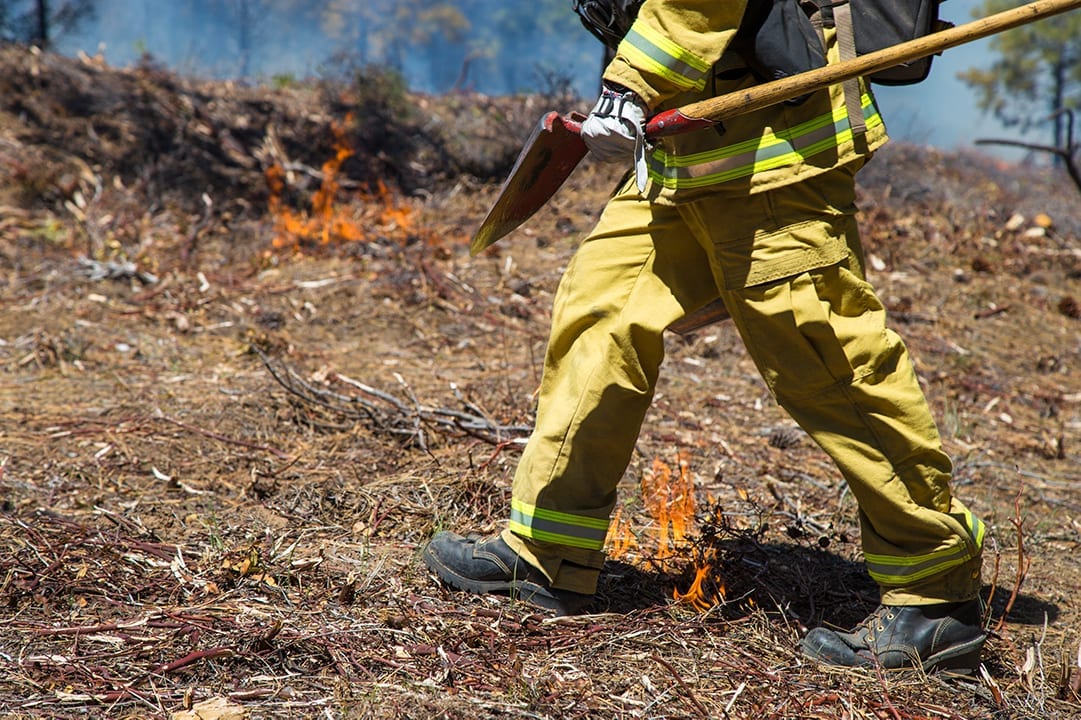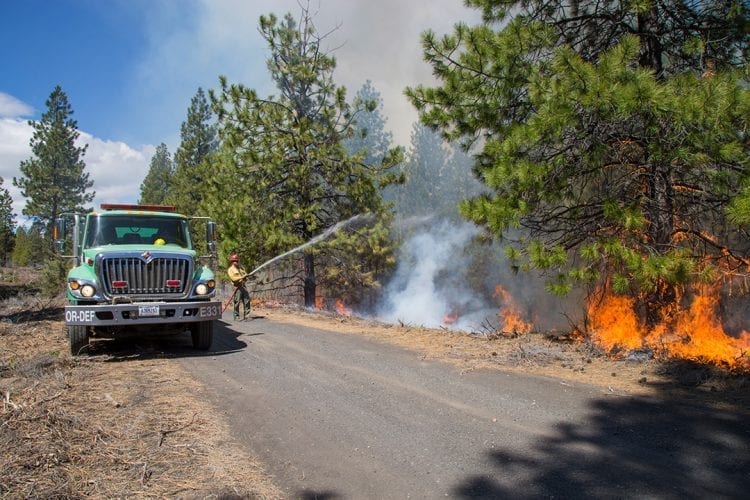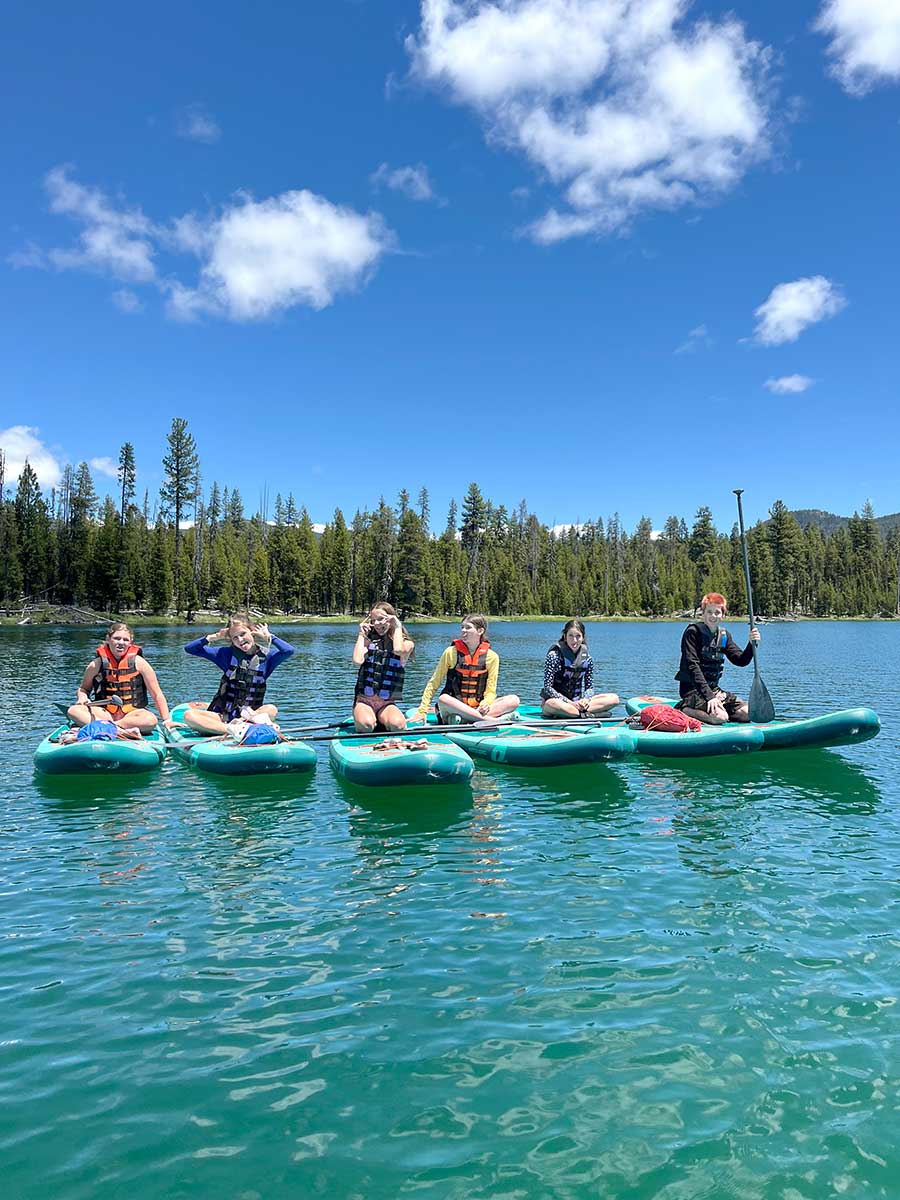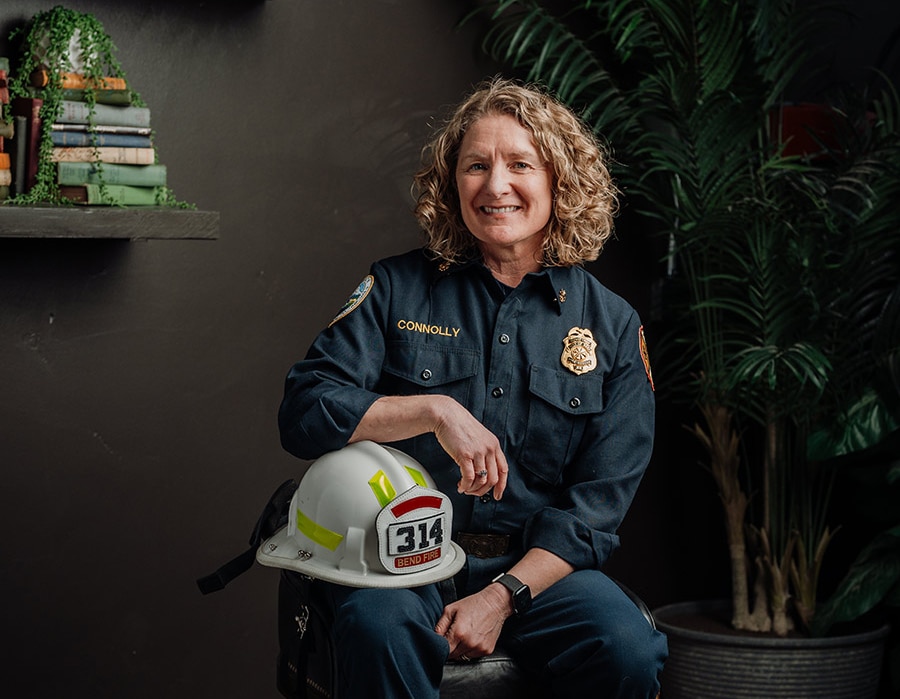New rules around smoke management allow for more prescribed burning, but critics say they don’t go far enough.
It’s a perfect late spring day in Bend. A powder-blue sky contrasts with the craggy, snow-dusted peaks on the western horizon. It’s the kind of afternoon that makes even the most dedicated office denizen want to put down the spreadsheet and grab a mountain bike or running shoes. But today the usually busy biking and hiking trails just west of Bend are largely deserted, closed temporarily so Forest Service employees clad in green khaki pants and yellow, fire-resistant Nomex shirts can do something that predecessors at the once notoriously fire-adverse federal agency could never have imagined—stand back and watch trees burn.
It’s nothing terribly unusual. In fact, it’s regular housekeeping for the Forest Service, which manages much of the public land around Bend and burns anywhere from 1,000 to 6,000 acres of forest land annually in the spring and fall. The burns help rejuvenate the forest and create a buffer between wildfire-prone public lands and the city of Bend, where population growth, particularly on the west side of the city, has encroached on the nearby forest.
When everything goes right, a plume of smoke rises over the forest canopy and then disperses on the prevailing winds, as it does on this day. On the ground, fire engulfs some smaller trees and brush, but barely scars the larger trees that will benefit from less competition and be better prepared for a real wildfire, should it arrive. When it doesn’t go as planned, the smoke from these controlled fires lingers in the foothills, and as the air cools, drops into the river canyon where it often drifts into Bend, aggravating allergies or worse.
A Lingering Issue
The question of how to deal with these smoke “intrusions” vexes fire managers, public health officials, public interest groups and politicians. Until this year, Oregon’s air quality managers enforced what was essentially a zero-tolerance policy for smoke derived from prescribed fires. That policy severely limited when, where and for how long forest managers could light fires. It also created a huge backlog of prescribed fire projects (more than 100,000 acres) that managers say would take decades to complete even if no more acres were added to the roster. But more are being added every day. Some 100,000 acres of fire-ready projects are set to come on-line in the next few years across the Deschutes National Forest.
In an effort designed to find some middle ground between protecting public health and promoting healthy forests, the state of Oregon, led by the Department of Forestry, rewrote the rules around smoke management this year. The zero-tolerance policy was abandoned in favor of a new rule that sets smoke exposure limits that are based on federal air quality standards set by the Environmental Protection Agency.

“If we really want to protect our communities, then we are going to have to burn more,” said John Allen, the outgoing Deschutes Forest Supervisor, in a May interview. “It’s unfortunate. You don’t want to have fear-driven motivation, but Paradise (California), the Camp Fire, can happen here,” said Allen, referencing the deadly fire that swept through the community of Paradise, California, outside Chico, last year. That fire, which was sparked by a utility line, killed eighty-five people, many of whom burned to death in their cars attempting to evacuate the fast-moving blaze.
“Our responsibility is to make the public aware of that possibility, and to try to reduce the risk of that happening here,” Allen said.
Community Safety
The issue of community safety gained urgency in recent years as the fire season has grown longer and hotter, and the prospect of a large fire near Bend seems less a matter of if, but when. A recent survey that looked at several factors contributing to wildfire risk exposure put Bend as one of the five most at-risk cities in Oregon (Redmond and Prineville were also in the top ten). Another report by the Forest Service listed Bend as one of the most at-risk for wildfire among cities in the entire West. A mix of climate, a century of fire suppression on public lands, and people’s desire to live closer to the forest in places like Bend, have all contributed to the problem.
Prescribed Burning or Not
There is no silver bullet, but nearly everyone agrees that prescribed, or controlled, burns are the most cost-effective way to create the important buffer zones between cities and forests. These controlled fires are intentionally set on pre-determined parcels, usually under 400 acres, where low-intensity fire can be used to remove smaller trees and vegetation. The fires are closely monitored by fire suppression crews and usually burn out within a few hours.
They also perform important ecological functions in places like Central Oregon where the forests evolved with fire as an integral part of the natural system, a key check in a system of checks and balances that created the mature, healthy ponderosa forests that drew lumber barons to the area more than a century ago. Those forests are long gone, replaced by a second-growth forest of largely uniformly aged, fire-prone trees and supplemented by thick brush that just adds more fuel to the mix.
“We can’t throw more air tankers and fire trucks at the problem,” said Bob Madden, a veteran wildland firefighter and deputy chief of fire operations at the city of Bend.
Madden heads up the city’s coordinated efforts to deal with the wildfire threat. He said the key is getting ahead of the problem by identifying opportunities and having a cohesive strategy.
“We have to make the community safe, and we have to make the forest more resilient. You still need to have a response, but in the past that’s where all of our focus has been, and it’s totally reactive,” Madden said.
Being Proactive
Being proactive means smarter urban planning that incorporates fire-resistant home designs, coordinated responses to fires including evacuation and sheltering plans, and well-designed street grids that can handle a high volume of traffic in a short window to get residents out of harm’s way. But the best tactic is to keep fire away from the city by promoting good forest management, including using prescribed fire.
Both Madden and Allen cited the example of the 2017 Milli Fire in Sisters where firefighters were able to contain a blaze that threatened dozens of homes. The fire slowed when it reached an area where the Forest Service had previously conducted a prescribed burn, essentially robbing it of fuel.
“Like most things in life there are trade-offs,” Allen said. “If it hadn’t been for our prescribed fire and fuel treatments, we would have lost the Tollgate and Crossroads subdivisions. And those are the trade-offs.”

Balancing Act
The state’s new smoke management rules will help bring a little more balance to the public health versus public safety debate, said Allen. This year the Forest Service is on track to burn roughly 6,000 acres, most of it around Bend, Sisters and Sunriver, in an area dubbed the WUI (wildland urban interface). That’s more than the agency has been able to burn in any previous year, thanks in large part to the new rules that allow smoke into populated areas, up to certain thresholds.
However, Allen would like to see the state go further, by setting those thresholds at the federal clean air standards, instead of the more restrictive standards that the state adopted as part of a year-plus review process. One of the major sticking points is a one-hour standard adopted at the request of the Oregon Health Authority (OHA) that is designed to limit intense short-term smoke exposure. When those levels are exceeded, the Oregon Department of Environmental Quality (DEQ) and the Oregon Department of Forestry (ODF) are charged with working with the offending agency or landowner—in Bend that’s usually the Forest Service—to determine why the threshold was breached. The DEQ won’t hand out monetary fines, but they want violators to avoid a repeat offense. DEQ says it’s a learning process as the agency works to establish best practices around the new clean air rules. But there are consequences. Exceeding an air quality threshold on a burn means that a burn in similar size is not likely to be permitted in the future under similar conditions.
“Even though they say it’s a learning process, the quote from the Deschutes National Forest is that, ‘learning equals limiting’,” said Pete Caligiuri, a forest ecologist with The Nature Conservancy in Bend.
Like Forest Supervisor Allen, Caligiuri would like the state to adopt the federal clean air standards, which give more flexibility when it comes to forest management. That’s something that makes sense in Central Oregon where the forests evolved with wildfire and smoke is a natural part of the landscape. More flexibility also decreases the chances of a wildfire spreading near Bend and other Central Oregon communities—something that would have a devastating impact on the landscape and the area’s smoke sensitive populations, including the elderly, the sick and the young, he said.
“Basically by creating this rule, you’re inadvertently creating a disincentive for us to get the highest priority burning done in the wildland urban area,” Caligiuri said.
This is evidenced by the fact that one of the burns undertaken this year near Bend in a high priority area for the Forest Service, violated the one-hour threshold without violating the twenty-four hour standard set by the state and EPA, Caligiuri said.
The current approach doesn’t do enough to balance both sides of the equation.
“We are saying that we are not inventing this [wildfire risk]. Help us think a little more holistically. Help us at least do what we can to put our forests and our community on a safer trajectory here,” he said.

Risk and Responsibility
The new rules were rolled out statewide in April around the start of the prescribed burn season when the forest begins to dry out, but before the heat of the summer when conditions are harder to control. They were the product of input from half a dozen community meetings including two in Central Oregon. They included input from three state agencies, a stakeholder group and federal agencies, including the Forest Service. The goal from the beginning was to provide more leeway to managers like Allen who would like to address the backlog of burn projects, which he said will improve forest health while protecting homes and assets like wildlife habitat and the popular hiking and mountain biking trails that help to drive the region’s tourism economy.
Michael Orman oversees DEQ’s clean air program for the state and said the smoke management rules are revisited once every decade or so, but this process was different in scope and the intent.
“Most of the reviews have been toward more regulation,” Orman said. “Recently, with this last review, there was some pushback based on the reality that wildfire was destroying a lot of the forest, and that we need to do more prescribed burning. The idea was to allow for more opportunity to do that, and that not allowing [smoke] intrusions into [cities] definitely needed to change.”
But just where to draw the line when it came to acceptable levels was a matter of contention from the beginning. Public land managers and forest advocates like Caligiuri wanted more flexibility and a recognition that constricting burning to small acreages in just a few days each season could put the entire community and resource at risk.
On the other side, the Oregon Health Authority wanted protections for smoke sensitive populations. OHA was particularly concerned about short-term events where sensitive populations might be exposed to a high dosage of smoke. The agency said that these types of incidents aren’t covered by the federal standards that average exposures over twenty-four hours, and, therefore, tend to minimize the severity of events that are focused over a shorter window.
“There is really strong evidence that when you reach a certain level of exposure in a short period of time, as short as one hour, that it causes health problems for certain vulnerable populations,” said Kirsten Aird, OHA’s chronic disease program manager who worked on the new rules.
Averaging those incidents out over twenty-four hours doesn’t adequately account for that risk, said Aird. While the one-hour threshold may not be part of the federal guidelines, it’s based on the EPA’s own research that was included in its Integrated Science Assessment released in October.
“It’s over 1,000 pages and decades of research. I don’t want to minimize how very solid the research is,” Aird said.
In the end, the state settled on a compromise. Communities that could develop a plan to inform and protect their vulnerable populations could apply for an exemption to the one-hour standard. Bend and Deschutes County are currently in the process of seeking that exemption, but the initial application filed by Deschutes County on Bend’s behalf was rescinded in April at the state’s request. Deschutes County forester Ed Keith, who worked on the rules and the exemption, said the state requested that the county withdraw the application and rework it or face the prospect of the state formally rejecting the request.
Keith said the state has asked for a more detailed communication strategy and contingency plans, which can include things like opening clean air shelters. As of early June, Keith and other team members were working on a revised application. That will include actions like public service announcements and mass media bulletins, and direct outreach to smoke sensitive populations through text messages.
In the end, though, people living in Central Oregon will have to learn to deal with smoke whether from prescribed burns or the ever more frequent wildfires, Keith said.
“Some of this is a level of personal responsibility. I can’t come into your house and close your windows for you at night. But that’s the best thing you can do to help yourself,” Keith said.
[rl_gallery id=”15753″]





